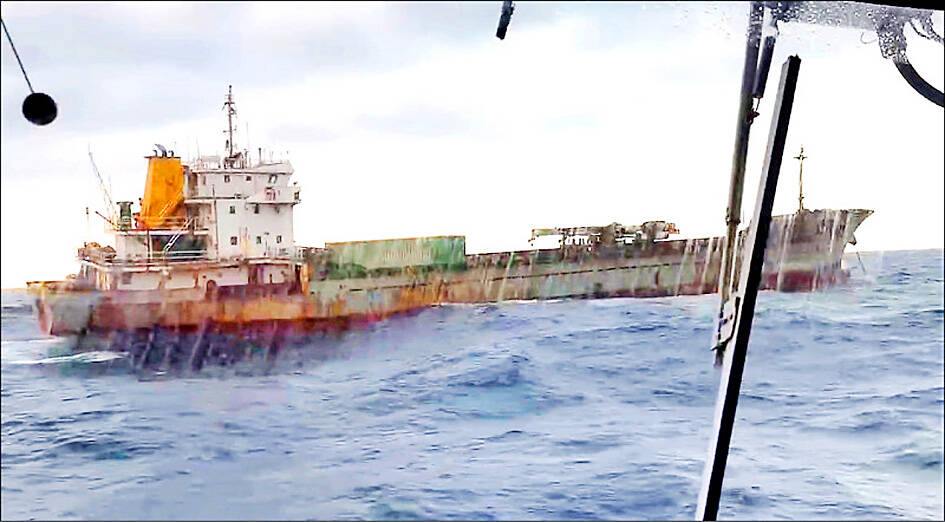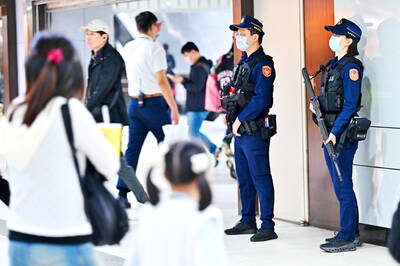Special monitoring zones would be established around undersea cables to prevent possible “gray zone” tactics by China, the Ministry of National Defense said yesterday.
The Shunxing-39, a Cameroon-flagged cargo vessel, on Monday last week allegedly damaged an undersea cable off northern Taiwan by dragging its anchor over it.
Colonel Hu Chung-hua (胡中華) said ministry officials have met with Coast Guard Administration (CGA) representatives and other agencies to collaborate on potential preventive action and intelligence sharing.

Photo: Fang Wei-li, Taipei Times
Colonel Lee Chang-fu (李昌富) said the ministry would establish special monitoring zones in Yilan County’s Toucheng Township (頭城), New Taipei City’s Tamsui (淡水) and Bali (八里) districts, Penghu County and Pingtung County’s Fangshan Township (枋山).
Suspicious ships loitering near these areas would be reported to the CGA for investigation, Lee said, adding that the navy would dispatch ships to assist CGA operations if the latter makes such a request.
The ministry is aware of the possibility of a large-scale sabotage of undersea cables and has set up multiple networks to prevent a communications blackout, Colonel Lei Yung-chi (雷詠淇) said.
The National Security Bureau in a report submitted to the Legislative Yuan ahead of a Foreign Affairs and National Defense Committee meeting today said that undersea cable destruction incidents — which have occurred seven to eight times in Taiwan over the past three years — showed that information network resilience and the establishment of backup communication methods were critical national security issues.
Ships flying flags of convenience are entitled to claim “innocent passage” under international law, but such behaviors have become a method that foreign powers use to threaten Taiwan, it said.
Patrols should prioritize the maritime zones near undersea cable landing stations, it said.
Ships flying flags of convenience of countries with a history of falsifying their customs reports should be prioritized for inspections, the agency said.
CGA officers should board and inspect the Maritime Mobile Service Identity and automatic identification systems of such ships once they are within 24 nautical miles (44km) of Taiwan, near the special monitoring zones or have asked to enter Taiwanese ports, it said.
Separately, the Ministry of Digital Affairs (MODA) said it is adopting policies to reinforce communications resilience throughout the country.
Efforts would include asking industry owners to conduct risk assessment reports, establish security protocols, increase the number of undersea cables and cable landing stations, and establish server rooms for additional redundancy, the MODA said.
The ministry has set up 773 non-geostationary orbit ground stations, 700 of which would help ensure Taiwan’s command structure retains its communications capability if undersea cables or microwave telecommunications are severed, the MODA said.
Additional reporting by Wu Che-yu

TRAGEDY STRIKES TAIPEI: The suspect died after falling off a building after he threw smoke grenades into Taipei Main Station and went on a killing spree in Zhongshan A 27-year-old suspect allegedly threw smoke grenades in Taipei Main Station and then proceeded to Zhongshan MRT Station in a random killing spree that resulted in the death of the suspect and two other civilians, and seven injured, including one in critical condition, as of press time last night. The suspect, identified as a man surnamed Chang Wen (張文), allegedly began the attack at Taipei Main Station, the Taipei Fire Department said, adding that it received a report at 5:24pm that smoke grenades had been thrown in the station. One man in his 50s was rushed to hospital after a cardiac arrest

SAFETY FIRST: Double the number of police were deployed at the Taipei Marathon, while other cities released plans to bolster public event safety Authorities across Taiwan have stepped up security measures ahead of Christmas and New Year events, following a knife and smoke bomb attack in Taipei on Friday that left four people dead and 11 injured. In a bid to prevent potential copycat incidents, police deployments have been expanded for large gatherings, transport hubs, and other crowded public spaces, according to official statements from police and city authorities. Taipei Mayor Chiang Wan-an (蔣萬安) said the city has “comprehensively raised security readiness” in crowded areas, increased police deployments with armed officers, and intensified patrols during weekends and nighttime hours. For large-scale events, security checkpoints and explosives

PUBLIC SAFETY: The premier said that security would be tightened in transport hubs, while President Lai commended the public for their bravery The government is to deploy more police, including rapid response units, in crowded public areas to ensure a swift response to any threats, President William Lai (賴清德) said yesterday after a knife attack killed three people and injured 11 in Taipei the previous day. Lai made the remarks following a briefing by the National Police Agency on the progress of the investigation, saying that the attack underscored the importance of cooperation in public security between the central and local governments. The attack unfolded in the early evening on Friday around Taipei Main Station’s M7 exit and later near the Taipei MRT’s Zhongshan

A car bomb killed a senior Russian general in southern Moscow yesterday morning, the latest high-profile army figure to be blown up in a blast that came just hours after Russian and Ukrainian delegates held separate talks in Miami on a plan to end the war. Kyiv has not commented on the incident, but Russian investigators said they were probing whether the blast was “linked” to “Ukrainian special forces.” The attack was similar to other assassinations of generals and pro-war figures that have either been claimed, or are widely believed to have been orchestrated, by Ukraine. Russian Lieutenant General Fanil Sarvarov, 56, head